What's new in Intent Architect (May 2024)
Welcome to the May 2024 edition of highlights of What's New in Intent Architect.
We’re thrilled to announce that our team has been working diligently on our upcoming 4.3 release, focused on front end automation—a long-term goal we are excited to achieve. Our initial release will feature a Blazor implementation, and we aim to have an alpha release available by the end of June.
We value your input and feedback, and we invite you to try it out. If you're interested in participating in the trial, please reach out to us at sarah@intentarchitect.com.
Highlights
- Kafka Publish/Subscribe (beta) - A new module which allows you to use Kafka publishing and subscription of integration messages.
IDistributedCachesupport (beta) - Use Redis or memory to cache application data.- Entity Framework Core second level caching (beta) - Cache the results of EF queries.
- Improvements to Service model modelling with the advanced mapping system - This paradigm now has more parity with the CQRS paradigm .
- Explicitly specify Default Schema name for Entity Framework - Specify a default schema name for Entity Framework within your Intent Architect application.
More updates
- CRUD support for mapping literals - This paradigm now has more parity with the CQRS paradigm.
- Value Objects can now be represented as
Recordsin code - This update allows you to have Value Objects be generated into C# asrecordtypes. - Change the installation path of Intent Architect - On Windows it is now possible to install Intent Architect to a location other than
Program Files.
Update details
Kafka Publish/Subscribe (beta)
You can now use Kafka to realize your inter-application eventing design from Intent Architect. Model your message publishing and subscriptions as you normally would using the Eventing Modeler and the new Intent.Eventing.Kakfka module will automatically generate Kafka Producers, Consumers and handlers for you allowing you interact with it using the same IEventBus interface in the same way as our other eventing technologies. You can also read more about the module here.
Available from:
- Intent.Eventing.Kakfka 1.0.0-beta.2
IDistributedCache support (beta)
Support is now available for distributed caching for an application through the IDistributedCache and IDistributedCacheWithUnitOfWork interfaces. A distributed cache is a cache shared by multiple app servers, typically maintained as an external service to the app servers that access it.
Support for the following the IDistributedCache implementations are immediately available:
Available from:
- Intent.AspNetCore.DistributedCaching 1.0.0-beta.0
Entity Framework Core second level caching (beta)
It is now possible to enable second level caching for Entity Framework Core through use of the EFCoreSecondLevelCacheInterceptor NuGet package.
Second level caching is a query cache. The results of EF commands will be stored in the cache, so that the same EF commands will retrieve their data from the cache rather than executing them against the database again.
Caching can be opted into on by using the .Cacheable(...) IQueryable extension method or enabled globally.
For further details on using second level caching, refer to the library's README.
Available from:
- Intent.EntityFrameworkCore.SecondLevelCaching 1.0.0-beta.0
Improvements to Service Model modelling with the advanced mapping system
Service Operations can now be mapped onto domain entity Constructors and Operations.
For example given this domain:
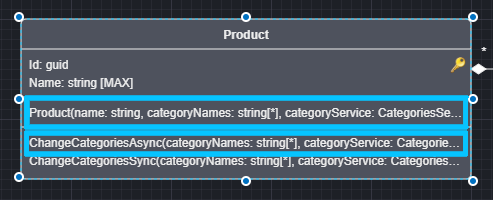
You can now map service end points as follows:
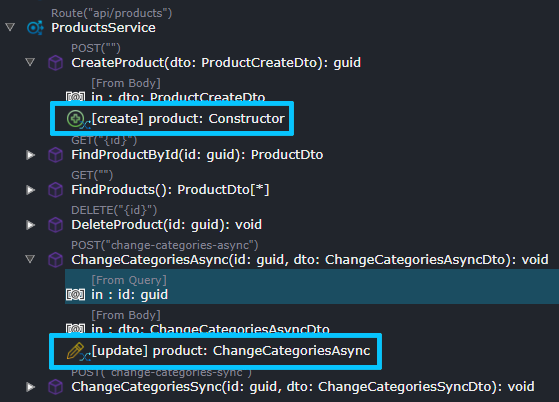
Available from:
- Intent.Application.ServiceImplementations.Conventions.CRUD 5.0.7
Explicitly specify Default Schema name for Entity Framework
Specify a default schema name for Entity Framework within your Intent Architect application.
You can locate this setting on the Settings page under the Database Settings section:

It will set the default schema for all entities defined in the ApplicationDbContext:
protected override void OnModelCreating(ModelBuilder modelBuilder)
{
base.OnModelCreating(modelBuilder);
modelBuilder.HasDefaultSchema("accounts");
ConfigureModel(modelBuilder);
}
And it will configure the ApplicationDbContext's History Table accordingly too.
services.AddDbContext<ApplicationDbContext>((sp, options) =>
{
options.UseSqlServer(
configuration.GetConnectionString("DefaultConnection"),
b =>
{
b.MigrationsAssembly(typeof(ApplicationDbContext).Assembly.FullName);
b.MigrationsHistoryTable(HistoryRepository.DefaultTableName, "accounts");
});
options.UseLazyLoadingProxies();
});
Available from:
- Intent.EntityFrameworkCore 5.0.6
CRUD support for mapping literals
When mapping CRUD implementation you can now specify literals, as opposed to mappings, for example:

Will now produce the following code:

Available from:
- Intent.Application.MediatR.CRUD 6.0.10
Value Objects can now be represented as Records in code
This update allows you to have Value Objects be generated into C# as record types.
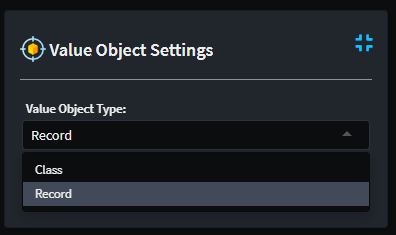
Example:
Value Objects in the Domain designer:
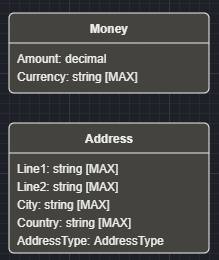
public record Money(decimal Amount, string Currency);
public record Address(string Line1, string Line2, string City, string Country, AddressType AddressType);
Available from:
- Intent.ValueObjects 4.2.0
Change the installation path of Intent Architect
Intent Architect's Windows installer will now allow you to change the installation path of Intent Architect during initial installation.
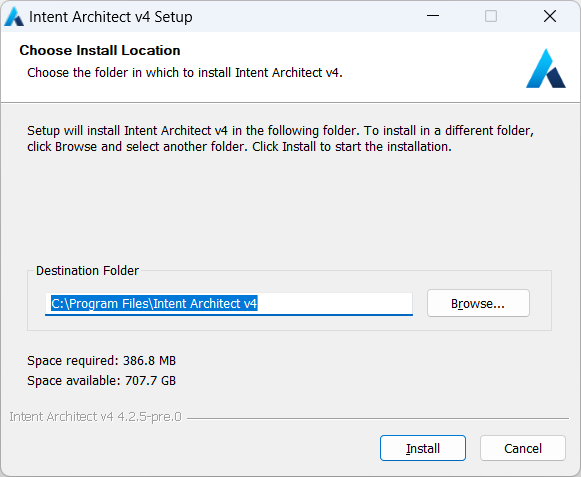
Available from:
- Intent Architect 4.2.5